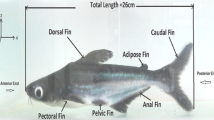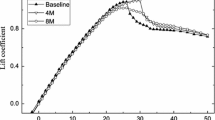Abstract
Our aim was to investigate the three-dimensional (3D) vortex ring in the wake of a tail fin and to clarify the propulsion mechanism of dolphins and fish. In this study, we replaced a tail fin in pitching motion with an oscillating wing having a drive unit. The flow fields around the wing were measured by stereoscopic particle image velocimetry. To visualize the 3D structure of the vortex in the wake, we determined the flow fields in equally spaced cross-sectional planes. We reconstructed the 3D velocity fields from the velocity data with three components in two dimensions. We visualized the 3D vortex structure from these velocity data and plotted an iso-vorticity surface. As a result, we found that the vortex ring was generated by the kick-down and kick-up motions of the wing and that the wake structure was comparable with that obtained numerically. Moreover, we calculated the propulsive forces from the temporal variations in circulation and in the area surrounded by the vortex ring.













Similar content being viewed by others
References
Adrian RJ, Christensen KT, Liu Z-C (2000) Analysis and interpretation of instantaneous turbulent velocity fields. Exp Fluids 29:275–290
Alben S (2009) Simulating the dynamics of flexible bodies and vortex sheets. J Comput Phys 228:2587–2603
Anderson JM, Streitlien K, Barrett DS, Triantafyllou MS (1998) Oscillating foils of high propulsive efficiency. J Fluid Mech 360:41–72
Blondeaux P, Formarelli F, Guglielmini L, Triantafyllou MS, Verzicco R (2005) Numerical experiments on flapping foils mimicking fish-like locomotion. Phys Fluids 17(113601)
Breder CM (1926) The locomotion of fishes. Zoologica 4:159–297
Buchholz JHJ, Smits AJ (2006) On the evolution of the wake structure produced by a low-aspect-ratio pitching panel. J Fluid Mech 546:433–443
Buchholz JHJ, Smits AJ (2008) The wake structure and thrust performance of a rigid low-aspect-ratio pitching panel. J Fluid Mech 603:331–365
Coutanceau M, Defaye AY (1991) Circular cylinder wake configurations: a flow visualization survey. Appl Mech Rev 44:255–305
Dabiri JO, Gharib M (2005) The role of optimal vortex formation in biological fluid transport. Proc R Soc B272:1557–1560
Dickinson MH (1996) Unsteady mechanisms of force generation in aquatic and aerial locomotion. Am Zool 36:537–554
Dong H, Mittal R, Najjar FM (2006) Wake topology and hydrodynamic performance of low-aspect-ratio flapping foils. J Fluid Mech 566:309–343
Drucker EG, Lauder GV (1999) Locomotor forces on a swimming fish: three-dimensional vortex wake dynamics quantified using digital particle image velocimetry. J Exp Biol 202:2393–2412
Gharib M, Rambod E, Shariff K (1998) A universal time scale for vortex ring formation. J Fluid Mech 360:121–140
Hama FR (1962) Streaklines in a perturbed shear flow. Phys Fluid 5:644–650
Izumi K, Kuwahara K (1983) Unsteady flow field, lift and drag measurements of impulsively started elliptic cylinder and circular-arc airfoil. AIAA Paper 83–1711
Lamb H (1932) Hydrodynamics, 6th edn. Cambridge Univ. Press, Cambridge
Linden PF, Turner JS (2004) ‘Optimal’ vortex rings and aquatic propulsion mechanisms. Proc R Soc B271:647–653
Matsuuchi K, Miwa T, Nomura T, Sakakibara J, Shintani H, Ungerechts BE (2009) Unsteady flow field around a human hand and propulsive force in swimming. J Biomech 42:42–47
Milne-Thomson LM (1966) Theoretical aerodynamics. Macmillan, New York
Morikawa K, Grönig H (1995) Formation and structure of vortex systems around a translating and oscillating airfoil. Z Flugwiss Weltraumforsch 19:391–396
Müller UK, van den Heuvel BLE, Stamhuis EJ, Videler JJ (1997) Fish foot prints: morphology and energetics of the wake behind a continuously swimming mullet (Chelon labrosus Risso). J Exp Biol 200:2893–2906
Nauen JC, Lauder GV (2002) Hydrodynamics of caudal fin locomotion by chub mackerel, Scomber japonicus (Scombridae). J Exp Biol 205:1709–1724
Parker K, von Ellenrieder KD, Soria J (2005) Using stereo multigrid DPIV (SMDPIV) measurements to investigate the vortical skeleton behind a finite-span flapping wing. Exp Fluids 39:281–298
Parker K, Soria J, von Ellenrieder KD (2007a) Thrust measurements from a finite-span flapping wing. AIAA J 45(1):58–70
Parker K, von Ellenrieder KD, Soria J (2007b) Morphology of the forced oscillatory flow past a finite-span wing at low Reynolds number. J Fluid Mech 571:327–357
Prasad AK, Adrian RJ (1993) Stereoscopic particle image velocimetry applied to liquid flows. Exp Fluids 15:49–60
Prasad AK, Jensen K (1995) Scheimpflug stereocamera for particle image velocimetry in liquid flows. Appl Opt 34:7092–7099
Sakakibara J, Nakagawa M, Yoshida M (2004) Stereo-PIV study of flow around a maneuvering fish. Exp Fluids 36:282–293
Sane SP (2003) The aerodynamics of insect flight. J Exp Biol 206:4191–4208
Sengupta TK, Lim TT, Sajjan SV, Ganesh G, Soria J (2007) Accelerated flow past a symmetrical aerofoil: experiments and computations. J Fluid Mech 591:255–288
Soria J, New TH, Lim TT, Parker K (2003) Multigrid CCDPIV measurements of accelerated flow past an airfoil at an angle of attack of 30º. Exp Therm Fluid Sci 27:667–676
Taylor GI (1938) The spectrum of turbulence. Proc R Soc 164:476–490
Taylor GK, Nudds RL, Thomas ALR (2003) Flying and swimming animals cruise at a Strouhal number tuned for high power efficiency. Nature 425:707–711
Triantafyllou MS, Triantafyllou GS, Yue DKP (2000) Hydrodynamics of fishlike swimming. Ann Rev Fluid Mech 32:33–53
Triantafyllou MS, Techet AH, Hover FS (2004) Review of experimental work in biomimetic foils. IEEE J Oceanic Eng 29:585–594
Troolin DR, Longmire EK, Lai WT (2006) Time resolved PIV analysis of flow over a NACA 0015 airfoil with Gurney flap. Exp Fluids 41:241–254
von Ellenrieder KD, Parker K, Soria J (2003) Flow structures behind a heaving and pitching finite-span wing. J Fluid Mech 490:129–138
Wolfgang MJ, Triantafyllou MS, Yue DKP (1999) Visualization of complex near-body transport process in flexible-body propulsion. J Visual 2:143–151
Acknowledgments
This study was supported by a Grant-in-Aid for Challenging Exploratory Research (23650383) from the Japan Society for the Promotion of Science. The authors thank Professor Jun Sakakibara of the University of Tsukuba for providing many useful comments and the technical support for using the PIV measurement system. The authors also thank the reviewers for insightful comments and the editor for helpful guidance.
Author information
Authors and Affiliations
Corresponding author
Electronic supplementary material
Below is the link to the electronic supplementary material.
Supplementary material 1 (MPG 25096 kb)
Supplementary material 2 (MPG 15872 kb)
Supplementary material 3 (MPG 30604 kb)
Rights and permissions
About this article
Cite this article
Imamura, N., Matsuuchi, K. Relationship between vortex ring in tail fin wake and propulsive force. Exp Fluids 54, 1605 (2013). https://doi.org/10.1007/s00348-013-1605-4
Received:
Revised:
Accepted:
Published:
DOI: https://doi.org/10.1007/s00348-013-1605-4




